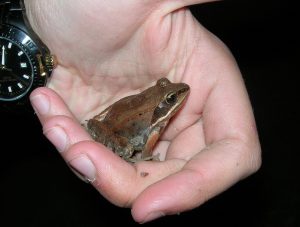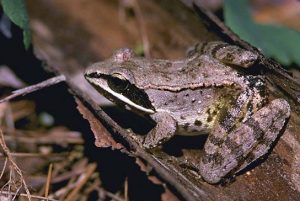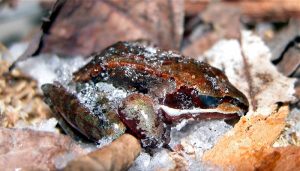With spring right around the corner, March is a great month to listen and look for frogs!
Many of our native amphibians will begin to awaken from their winter sleep with the longer days and warmer temperatures. Soon, vernal pools and ponds fed by the melting snow and spring rains will be filled with frog, toad, and salamander activity.
But how did these cold-blooded animals survive this winter’s record cold and repeated snow storms?
Many amphibians go through a period of brumation, which is similar to the hibernation of mammals. They find a safe place with a steady temperature away from the frost and cold, usually underground beneath the leaf litter, or sometimes underwater in the mud. Their metabolism slows down incredibly, decreasing their need for food or oxygen.
- Average size of a Wood Frog
- Frozen Wood Frog
One of the coolest adaptations for winter survival is the ability of some frogs to allow their bodies to actually freeze!
Wood frogs are actively being studied by scientists because of their amazing ability to freeze and thaw throughout the winter, without suffering from damage to their bodies.
When ice first reaches the skin of the frog, its body begins to go through interesting chemical processes. First, the water in the blood freezes, thanks to special proteins it contains. The ice starts to suck the water from the cells of the frogs body, but its liver produces large quantities of glucose (a type of sugar) to fill in the cells to keep them from breaking and preventing further water loss.
Human cells do not react like this–when our cells encounter freezing temperatures, the water is sucked out and the cells break and die. This results in frostbite, and even if the ice is removed from the skin, the damage is irreversible.
Wood frogs, however, can become frozen during the winter, with no beating heart or brain activity, and then thaw out once the temperature warms up again without any lasting damage.
- Timeframe of freezing




